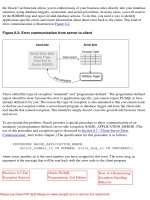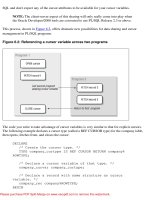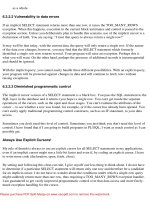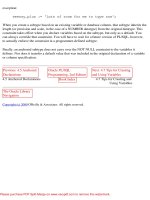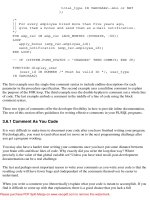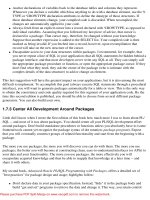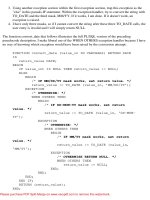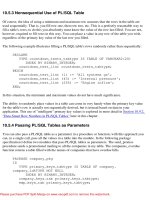oracle 8 sql reference
Bạn đang xem bản rút gọn của tài liệu. Xem và tải ngay bản đầy đủ của tài liệu tại đây (2.98 MB, 792 trang )
Oracle8™
SQL Reference
Release 8.0
December 1997
Part No. A58225-01
Oracle8™ Server SQL Reference
Part No. A58225-01
Release 8.0
Copyright © 1997 Oracle Corporation. All Rights Reserved.
Primary Author: Diana Lorentz
Contributors: Steve Bobrowski, Robert Jenkins, Susan Kotsovolos, Andre Kruglikov, Vishu Krishna,
Muralidhar Krishnaprasa, Michael Kung, Paul Lane, Nina Lewis, Lefty Leverenz, Phil Locke, William
Maimone, Mohammad Monajjemi, Rita Moran, Thomas Portfolio, Valarie Moore, Denis Raphaely, Rich-
ard Sarwal, Rick Wong
The programs are not intended for use in any nuclear, aviation, mass transit, medical, or other inher-
ently dangerous applications. It shall be licensee's responsibility to take all appropriate fail-safe, back
up, redundancy and other measures to ensure the safe use of such applications if the Programs are
used for such purposes, and Oracle disclaims liability for any damages caused by such use of the Pro-
grams.
This Program contains proprietary information of Oracle Corporation; it is provided under a license
agreement containing restrictions on use and disclosure and is also protected by copyright patent and
other intellectual property law. Reverse engineering of the software is prohibited.
The information contained in this document is subject to change without notice. If you find any problems
in the documentation, please report them to us in writing. Oracle Corporation does not warrant that this
document is error free.
If this Program is delivered to a U.S. Government Agency of the Department of Defense, then it is deliv-
ered with Restricted Rights and the following legend is applicable:
Restricted Rights Legend Programs delivered subject to the DOD FAR Supplement are 'commercial
computer software' and use, duplication and disclosure of the Programs shall be subject to the licensing
restrictions set forth in the applicable Oracle license agreement. Otherwise, Programs delivered subject to
the Federal Acquisition Regulations are 'restricted computer software' and use, duplication and disclo-
sure of the Programs shall be subject to the restrictions in FAR 52 227-14, Rights in Data General,
including Alternate III (June 1987). Oracle Corporation, 500 Oracle Parkway, Redwood City, CA 94065.
Oracle Call Interface, Oracle7, Oracle7 Server, Oracle8, Oracle Forms, Oracle Parallel Server, Net8, PL/
SQL, SQL*Net, Pro*C/C++, and SQL*Module are trademarks of Oracle Corporation, Redwood Shores,
California.
All other products or company names are used for identification purposes only, and may be trademarks
of their respective owners.
iii
Contents
Send Us Your Comments xv
Preface xvii
1 Introduction
History of SQL 1- 1
SQL Standards 1- 2
Embedded SQL 1- 3
Lexical Conventions 1- 4
Tools Support 1- 5
2 Elements of Oracle8 SQL
Literals 2-2
Text 2-2
Integer 2-3
Number 2-4
Datatypes 2-5
Nulls 2-31
Pseudocolumns 2-32
Comments 2-38
Database Objects 2-44
Schema Object Names and Qualifiers 2-47
Referring to Schema Objects and Parts 2-51
iv
3 Operators, Functions, Expressions, Conditions
Operators 3-1
SQL Functions 3-16
User Functions 3-60
Format Models 3-63
Expressions 3-78
Conditions 3-90
4 Commands
Summary of SQL Commands 4 - 2
Data Definition Language (DDL) Commands 4 - 2
Data Manipulation Language (DML) Commands 4 - 7
Transaction Control Commands 4 - 8
Session Control Commands 4 - 8
System Control Command 4 - 9
Embedded SQL Commands 4 - 10
ALTER CLUSTER 4 - 11
Altering Clusters 4 - 13
ALTER DATABASE 4 - 15
Examples 4 - 23
ALTER FUNCTION 4 - 26
Recompiling Standalone Functions 4 - 26
ALTER INDEX 4 - 28
Examples 4 - 35
ALTER PACKAGE 4 - 38
Recompiling Stored Packages 4 - 38
ALTER PROCEDURE 4 - 41
Recompiling Stored Procedures 4 - 41
ALTER PROFILE 4 - 43
Using Password History 4 - 45
Examples 4 - 45
ALTER RESOURCE COST 4 - 48
Altering Resource Costs 4 - 48
ALTER ROLE 4 - 51
Changing Authorizations 4 - 51
v
ALTER ROLLBACK SEGMENT 4 - 53
Altering Rollback Segments 4 - 54
ALTER SEQUENCE 4 - 56
Examples 4 - 57
ALTER SESSION 4 - 58
Enabling and Disabling the SQL Trace Facility 4 - 67
Using NLS Parameters 4 - 67
Changing the Optimization Approach and Mode 4 - 71
FIPS Flagging 4 - 71
Caching Session Cursors 4 - 71
Accessing the Database as if Connected to Another Instance in a Parallel Server 4 - 72
Closing Database Links 4 - 72
Forcing In-Doubt Distributed Transactions 4 - 73
Transaction Control in Procedures and Stored Functions 4 - 74
Parallel DML 4 - 74
ALTER SNAPSHOT 4 - 76
Examples 4 - 81
Specifying Rollback Segments 4 - 82
Primary Key Snapshots 4 - 82
Partitioned Snapshots 4 - 83
ALTER SNAPSHOT LOG 4 - 84
Modifying Physical Attributes 4 - 86
Adding Primary Key, ROWID, and Filter Columns 4 - 87
Partitioned Snapshot Logs 4 - 87
ALTER SYSTEM 4 - 88
Restricting Logons 4 - 97
Clearing the Shared Pool 4 - 97
Performing a Checkpoint 4 - 97
Checking Datafiles 4 - 98
Using Resource Limits 4 - 98
Global Name Resolution 4 - 99
Managing Processes for the Multithreaded Server 4 - 99
Using Licensing Limits 4 - 101
Switching Redo Log File Groups 4 - 102
Enabling and Disabling Distributed Recovery 4 - 103
vi
Terminating a Session 4 - 103
Disconnecting a Session 4 - 104
ALTER TABLE 4 - 106
Adding Columns 4 - 122
Modifying Column Definitions 4 - 123
Index-Organized Tables 4 - 125
LOB Columns 4 - 125
Nested Table Columns 4 - 126
REFs 4 - 127
Modifying Table Partitions 4 - 128
ALTER TABLESPACE 4 - 133
Using ALTER TABLESPACE 4 - 138
ALTER TRIGGER 4 - 141
Invalid Triggers 4 - 141
Enabling and Disabling Triggers 4 - 142
ALTER TYPE 4 - 144
Restriction 4 - 147
ALTER USER 4 - 150
Establishing Default Roles 4 - 152
Changing Authentication Methods 4 - 152
ALTER VIEW 4 - 154
Recompiling Views 4 - 154
ANALYZE 4 - 156
Restrictions 4 - 160
Collecting Statistics 4 - 160
Clusters 4 - 163
Deleting Statistics 4 - 163
Validating Structures 4 - 164
Listing Chained Rows 4 - 166
ARCHIVE LOG clause 4 - 167
Restrictions 4 - 169
AUDIT (SQL Statements) 4 - 170
Auditing 4 - 171
Statement Options for Database Objects 4 - 172
Statement Options for Commands 4 - 174
vii
Shortcuts for System Privileges and Statement Options 4 - 176
AUDIT (Schema Objects) 4 - 178
Object Options 4 - 179
Default Auditing 4 - 180
COMMENT 4 - 183
Using Comments 4 - 183
COMMIT 4 - 185
About Transactions 4 - 186
Ending Transactions 4 - 187
CONSTRAINT clause 4 - 188
Defining Integrity Constraints 4 - 192
NOT NULL Constraints 4 - 193
UNIQUE Constraints 4 - 193
PRIMARY KEY Constraints 4 - 195
Referential Integrity Constraints 4 - 196
CHECK Constraints 4 - 201
DEFERRABLE Constraints 4 - 204
Enabling and Disabling Constraints 4 - 205
CREATE CLUSTER 4 - 207
About Clusters 4 - 210
Cluster Keys 4 - 210
Types of Clusters 4 - 211
Cluster Size 4 - 212
Adding Tables to a Cluster 4 - 213
CREATE CONTROLFILE 4 - 215
Re-creating Control Files 4 - 218
CREATE DATABASE 4 - 219
Examples 4 - 223
CREATE DATABASE LINK 4 - 225
Creating Database Links 4 - 226
Current-User Database Links 4 - 227
Examples 4 - 228
CREATE DIRECTORY 4 - 230
Directory Objects 4 - 231
CREATE FUNCTION 4 - 232
viii
Examples 4 - 235
CREATE INDEX 4 - 237
Creating Indexes 4 - 243
Index Columns 4 - 243
Multiple Indexes Per Table 4 - 244
The NOSORT Option 4 - 244
NOLOGGING 4 - 245
Nulls 4 - 245
Creating Cluster Indexes 4 - 245
Creating Partitioned Indexes 4 - 246
Creating Bitmap Indexes 4 - 246
Creating Indexes on Nested Table Columns 4 - 247
CREATE LIBRARY 4 - 248
Examples 4 - 249
CREATE PACKAGE 4 - 250
Packages 4 - 251
CREATE PACKAGE BODY 4 - 254
Examples 4 - 255
CREATE PROCEDURE 4 - 259
Using Procedures 4 - 262
CREATE PROFILE 4 - 265
Using Profiles 4 - 268
Fractions in Dates 4 - 269
The DEFAULT Profile 4 - 269
CREATE ROLE 4 - 272
Using Roles 4 - 273
Roles Predefined by Oracle 4 - 273
CREATE ROLLBACK SEGMENT 4 - 275
Rollback Segments and Tablespaces 4 - 276
CREATE SCHEMA 4 - 278
Creating Schemas 4 - 278
CREATE SEQUENCE 4 - 281
Using Sequences 4 - 283
Sequence Defaults 4 - 284
Incrementing Sequence Values 4 - 284
ix
Caching Sequence Numbers 4 - 284
Accessing Sequence Values 4 - 285
CREATE SNAPSHOT 4 - 286
About Snapshots 4 - 291
Types of Snapshots 4 - 291
Refreshing Snapshots 4 - 292
Specifying Rollback Segments 4 - 294
Specifying Primary-Key or ROWID Snapshots 4 - 295
Partitioned Snapshots 4 - 296
CREATE SNAPSHOT LOG 4 - 297
Using Snapshot Logs 4 - 299
Recording Primary Keys, ROWIDs, and Filter Columns 4 - 300
CREATE SYNONYM 4 - 302
Using Synonyms 4 - 303
Scope of Synonyms 4 - 304
CREATE TABLE 4 - 306
Examples 4 - 321
LOB Column Example 4 - 322
Index-Organized Tables 4 - 323
Partitioned Tables 4 - 323
Object Tables 4 - 324
Nested Table Storage 4 - 325
REFs 4 - 325
CREATE TABLESPACE 4 - 328
About Tablespaces 4 - 330
CREATE TRIGGER 4 - 333
Using Triggers 4 - 336
Conditional Predicates 4 - 337
Parts of a Trigger 4 - 338
Types of Triggers 4 - 339
Snapshot Log Triggers 4 - 340
INSTEAD OF Triggers 4 - 342
User-Defined Types, LOB, and REF Columns 4 - 343
CREATE TYPE 4 - 345
Incomplete Object Types 4 - 351
x
Constructors 4 - 352
CREATE TYPE BODY 4 - 353
TYPE and TYPE BODY 4 - 355
CREATE USER 4 - 357
Verifying Users Through Your Operating System 4 - 359
Verifying Users Through the Network 4 - 360
Establishing Tablespace Quotas for Users 4 - 360
Granting Privileges to a User 4 - 360
CREATE VIEW 4 - 363
Using Views 4 - 366
The View Query 4 - 366
Join Views 4 - 368
Partition Views 4 - 369
Examples 4 - 370
Object Views 4 - 370
DEALLOCATE UNUSED clause 4 - 372
Deallocating Unused Space 4 - 372
DELETE 4 - 374
Using DELETE 4 - 377
Deleting from a Single Partition 4 - 378
The RETURNING Clause 4 - 378
DISABLE clause 4 - 380
Using the DISABLE Clause 4 - 381
DROP clause 4 - 384
Removing Integrity Constraints 4 - 384
DROP CLUSTER 4 - 386
Restrictions 4 - 386
DROP DATABASE LINK 4 - 388
Restrictions 4 - 388
Example 4 - 388
DROP DIRECTORY 4 - 389
Dropping a Directory 4 - 389
DROP FUNCTION 4 - 390
Dropping Functions 4 - 390
DROP INDEX 4 - 392
xi
Dropping an Index 4 - 392
DROP LIBRARY 4 - 393
Example 4 - 393
DROP PACKAGE 4 - 394
Dropping a Package 4 - 394
DROP PROCEDURE 4 - 396
Dropping a Procedure 4 - 396
DROP PROFILE 4 - 398
Dropping a Profile 4 - 398
DROP ROLE 4 - 399
Dropping a Role 4 - 399
DROP ROLLBACK SEGMENT 4 - 400
Dropping Rollback Segments 4 - 400
DROP SEQUENCE 4 - 401
Dropping Sequences 4 - 401
DROP SNAPSHOT 4 - 402
Dropping Snapshots 4 - 402
DROP SNAPSHOT LOG 4 - 403
Dropping Snapshot Logs 4 - 403
DROP SYNONYM 4 - 404
Dropping Synonyms 4 - 404
DROP TABLE 4 - 405
Dropping Tables 4 - 405
DROP TABLESPACE 4 - 407
Dropping Tablespaces 4 - 407
DROP TRIGGER 4 - 409
Dropping Triggers 4 - 409
DROP TYPE 4 - 410
Dropping Types 4 - 410
DROP TYPE BODY 4 - 412
Dropping Type Bodies 4 - 412
DROP USER 4 - 414
Dropping Users and Their Objects 4 - 414
DROP VIEW 4 - 416
Dropping Views 4 - 416
xii
ENABLE clause 4 - 417
Enabling and Disabling Constraints 4 - 419
How Oracle Validates Integrity Constraints 4 - 421
How to Identify Exceptions 4 - 421
Enabling Triggers 4 - 424
EXPLAIN PLAN 4 - 425
Using EXPLAIN PLAN 4 - 426
EXPLAIN PLAN and Partitioned Tables 4 - 427
EXPLAIN PLAN and Parallel DML 4 - 430
Filespec 4 - 431
Examples 4 - 432
GRANT (System Privileges and Roles) 4 - 434
Granting System Privileges and Roles 4 - 435
Granting the ADMIN OPTION 4 - 441
Other Authorization Methods 4 - 442
Examples 4 - 442
GRANT (Object Privileges) 4 - 444
Database Object Privileges 4 - 446
Synonym Privileges 4 - 448
Directory Privileges 4 - 448
Examples 4 - 449
INSERT 4 - 451
The VALUES Clause and Subqueries 4 - 454
Parallel DML 4 - 454
Inserting Into Views 4 - 454
The RETURNING Clause 4 - 455
Examples 4 - 455
LOCK TABLE 4 - 458
Locking Tables 4 - 459
NOAUDIT (SQL Statements) 4 - 461
Stopping Auditing 4 - 462
NOAUDIT (Schema Objects) 4 - 463
Examples 4 - 464
PARALLEL clause 4 - 465
Using the PARALLEL Clause 4 - 466
xiii
Nonpartitioned Tables and Indexes 4 - 466
Partitioned Tables and Indexes 4 - 467
Examples 4 - 467
RECOVER clause 4 - 469
Examples 4 - 471
RENAME 4 - 473
Renaming Objects 4 - 473
Restrictions 4 - 473
REVOKE (System Privileges and Roles) 4 - 475
Revoking Privileges 4 - 475
Revoking Roles 4 - 476
Limitations 4 - 476
Examples 4 - 477
REVOKE (Schema Object Privileges) 4 - 478
Revoking Object Privileges 4 - 480
Using FORCE 4 - 480
Revoking Multiple Identical Grants 4 - 480
Cascading Revokes 4 - 481
Examples 4 - 481
ROLLBACK 4 - 484
Rolling Back Transactions 4 - 484
Distributed Transactions 4 - 486
SAVEPOINT 4 - 487
Creating Savepoints 4 - 487
SELECT 4 - 489
Creating Simple Queries 4 - 493
Hierarchical Queries 4 - 495
GROUP BY Clause 4 - 499
HAVING Clause 4 - 500
UNION, UNION ALL, INTERSECT, and MINUS 4 - 501
ORDER BY Clause 4 - 501
FOR UPDATE Clause 4 - 503
Joins 4 - 505
SET CONSTRAINT(S) 4 - 514
Examples 4 - 514
xiv
SET ROLE 4 - 516
Privilege Domains 4 - 517
Examples 4 - 518
SET TRANSACTION 4 - 519
Establishing Read-Only Transactions 4 - 520
Assigning Transactions to Rollback Segments 4 - 521
STORAGE clause 4 - 523
Specifying Storage Parameters 4 - 526
Rollback Segments and MAXEXTENTS UNLIMITED 4 - 527
Examples 4 - 527
Subqueries 4 - 530
Using Subqueries 4 - 532
Using Flattened Subqueries 4 - 533
Correlated Subqueries 4 - 534
Selecting from the DUAL Table 4 - 535
Using Sequences 4 - 536
Distributed Queries 4 - 536
TRUNCATE 4 - 538
Truncating Tables and Clusters 4 - 539
Restrictions 4 - 540
Examples 4 - 540
UPDATE 4 - 542
Updating Views 4 - 545
Updating Partitioned Tables 4 - 546
Correlated Update 4 - 547
The RETURNING Clause 4 - 549
A Syntax Diagrams
B Oracle and Standard SQL
C Oracle Reserved Words and Keywords
Part No. A58225-01 -xv
Send Us Your Comments
Oracle8 SQL Reference, Release 8.0
Part No. A58225-01
Oracle Corporation welcomes your comments and suggestions on the quality and usefulness of this
publication. Your input is an important part of the information used for revision.
■ Did you find any errors?
■ Is the information clearly presented?
■ Do you need more information? If so, where?
■ Are the examples correct? Do you need more examples?
■ What features did you like most about this manual?
If you find any errors or have any other suggestions for improvement, please indicate the chapter,
section, and page number (if available). Please send your comments to
Server Technologies Documentation Manager
Oracle Corporation
500 Oracle Parkway
Redwood Shores, CA 94065
or e-mail comments to:
-xvi Oracle8 SQL Reference
xvii
Preface
This reference contains a complete description of the Structured Query Language
(SQL) used to manage information in an Oracle database.
Oracle SQL is a superset of the American National Standards Institute (ANSI) and
the International Standards Organization (ISO) SQL92 standard at entry level
conformance.
For information on PL/SQL, Oracle’s procedural language extension to SQL, see
PL/SQL User’s Guide and Reference.
Detailed descriptions of Oracle embedded SQL can be found in the Pro*C/C++
Precompiler Programmer’s Guide, SQL*Module for Ada Programmer’s Guide, and the
Pro*COBOL Precompiler Programmer’s Guide.
Features and Functionality
Oracle8 SQL Reference contains information that describes the features and
functionality of the Oracle8 and the Oracle8 Enterprise Edition products. Oracle8
and Oracle8 Enterprise Edition have the same basic features. However, several
advanced features are available only with the Enterprise Edition, and some of these
are optional. For example, to use the CREATE TYPE command, you must have the
Enterprise Edition and the Objects Option.
For information about the differences between Oracle8 and the Oracle8 Enterprise
Edition and the features and options that are available to you, see Getting to Know
Oracle8 and the Oracle8 Enterprise Edition.
Audience
This reference is intended for all users of Oracle SQL.
xviii
How this Reference Is Organized
This reference is divided into the following parts:
Chapter 1: Introduction
This chapter defines SQL and describes its history as well as the advantages of
using it to access relational databases.
Chapter 2: Elements of Oracle8 SQL
This chapter describes the basic building blocks of an Oracle database and the
elements of Oracle SQL.
Chapter 3: Operators, Functions, Expressions, Conditions
This chapter describes how to use SQL operators and functions to combine data
into expressions and conditions.
Chapter 4: Commands
This chapter lists and describes all of the SQL commands in alphabetical order.
Appendix A: Syntax Diagrams
This appendix describes how to read the syntax diagrams that appear in this
reference.
Appendix B: Oracle and Standard SQL
This appendix describes Oracle compliance with ANSI and ISO standards and lists
Oracle extensions beyond the standards.
Appendix C: Oracle Reserved Words and Keywords
This appendix lists Oracle reserved words and keywords.
Conventions Used in this Reference
This section explains the conventions used in this book including:
■ Text
■ Syntax Diagrams and Notation
■ Code Examples
■ Example Data
xix
Text
The text in this reference adheres to the following conventions:
Syntax Diagrams and Notation
Syntax Diagrams.
This reference uses syntax diagrams to show SQL commands in
Chapter 4, “Commands”, and to show other elements of the SQL language in
Chapter 2, “Elements of Oracle8 SQL”, and Chapter 3, “Operators, Functions,
Expressions, Conditions”. These syntax diagrams use lines and arrows to show
syntactic structure, as shown here:
If you are not familiar with this type of syntax diagram, refer to Appendix A,
“Syntax Diagrams”, for a description of how to read them. This section describes
the components of syntax diagrams and gives examples of how to write SQL
statements. Syntax diagrams are made up of these items:
Keywords.
Keywords have special meanings in the SQL language. In the syntax
diagrams, keywords appear in UPPERCASE. You must use keywords in your SQL
statements exactly as they appear in the syntax diagram, except that they can be
either uppercase or lowercase. For example, you must use the CREATE keyword to
begin your CREATE TABLE statements just as it appears in the CREATE TABLE
syntax diagram.
Parameters.
Parameters act as placeholders in syntax diagrams. They appear in
lowercase. Parameters are usually names of database objects, Oracle datatype
names, or expressions. When you see a parameter in a syntax diagram, substitute
an object or expression of the appropriate type in your SQL statement. For
example, to write a CREATE TABLE statement, use the name of the table you want
UPPERCASE Uppercase text calls attention to SQL commands,
keywords, filenames, and initialization parameters.
italics Italicized text calls attention to definitions of terms and
parameters of SQL commands.
COMMIT
WORK
COMMENT ’ text ’
FORCE ’ text ’
, integer
;
xx
to create, such as EMP, in place of the table parameter in the syntax diagram. (Note
that parameter names appear in italics in the text.)
This lists shows parameters that appear in the syntax diagrams and provides
examples of the values you might substitute for them in your statements:
Parameter Description Examples
table The substitution value must be the name of
an object of the type specified by the
parameter. For a list of all types of objects, see
the section, “Schema Objects” on page 2-44.
emp
c The substitution value must be a single
character from your database character set.
T
s
’text’ The substitution value must be a text string in
single quotes. See the syntax description of
’text’ in “Text” on page 2-2.
’Employee records’
char The substitution value must be an expression
of datatype CHAR or VARCHAR2 or a
character literal in single quotes.
ename
’Smith’
condition The substitution value must be a condition
that evaluates to TRUE or FALSE. See the
syntax description of condition in
“Conditions” on page 3-90.
ename >’A’
date
d
The substitution value must be a date
constant or an expression of DATE datatype.
TO_DATE(
’01-Jan-1994’,
’DD-MON-YYYY’)
expr The substitution value can be an expression of
any datatype as defined in the syntax
description of expr in “Expressions” on
page 3-78.
sal + 1000
integer The substitution value must be an integer as
defined by the syntax description of integer in
“Integer” on page 2-3.
72
label The substitution value must be an expression
of datatype MLSLABEL. For information on
such expressions, see your Trusted Oracle
documentation.
TO_LABEL(
’SENSITIVE:ALPHA’)
xxi
Code Examples
This reference contains many examples of SQL statements. These examples show
you how to use elements of SQL. The following example shows a CREATE TABLE
statement:
CREATE TABLE accounts
( accno NUMBER,
owner VARCHAR2(10),
balance NUMBER(7,2) );
Note that examples appear in a different font than the text.
number
m
n
The substitution value must be an expression
of NUMBER datatype or a number constant
as defined in the syntax description of number
in “Number” on page 2-4.
AVG(sal)
15 * 7
raw The substitution value must be an expression
of datatype RAW.
HEXTORAW(’7D’)
rowid The substitution value must be an expression
of datatype ROWID.
AAAAZzAABAAABrXAAA
subquery The substitution value must be a SELECT
statement that will be used in another SQL
statement. See “Subqueries” on page 4-530.
SELECT ename
FROM emp
:host_variable The substitution value must be the name of a
variable declared in an embedded SQL
program. This reference also uses :host_integer
and :d to indicate specific datatypes.
:employee_number
cursor The substitution value must be the name of a
cursor in an embedded SQL program.
curs1
db_name The substitution value must be the name of a
nondefault database in an embedded SQL
program.
sales_db
db_string The substitution value must be the database
identification string for a Net8 database
connection. For details, see the user’s guide
for your specific Net8 protocol.
statement_name
block_name
The substitution value must be an identifier
for a SQL statement or PL/SQL block.
s1
lab1
Parameter Description Examples
xxii
Examples follow these case conventions:
■ Keywords, such as CREATE and NUMBER, appear in uppercase.
■ Names of database objects and their parts, such as ACCOUNTS and ACCNO,
appear in lowercase, although they appear in uppercase in the text.
SQL is not case sensitive (except for quoted identifiers), so you need not follow
these conventions when writing your own SQL statements, although your
statements may be easier for you to read if you do.
Some Oracle tools require you to terminate SQL statements with a special character.
For example, the code examples in this reference were issued through SQL*Plus,
and therefore are terminated with a semicolon (;). If you issue these example
statements to Oracle, you must terminate them with the special character expected
by the Oracle tool you are using.
Example Data
Many of the examples in this reference operate on sample tables. The definitions of
some of these tables appear in a SQL script available on your distribution medium.
On most operating systems the name of this script is UTLSAMPL.SQL, although its
exact name and location depend on your operating system. This script creates
sample users and creates these sample tables in the schema of the user SCOTT:
CREATE TABLE dept
(deptno NUMBER(2) CONSTRAINT pk_dept PRIMARY KEY,
dname VARCHAR2(14),
loc VARCHAR2(13) );
CREATE TABLE emp
(empno NUMBER(4) CONSTRAINT pk_emp PRIMARY KEY,
ename VARCHAR2(10),
job VARCHAR2(9),
mgr NUMBER(4),
hiredate DATE,
sal NUMBER(7,2),
comm NUMBER(7,2),
deptno NUMBER(2) CONSTRAINT fk_deptno REFERENCES dept );
CREATE TABLE bonus
(ename VARCHAR2(10),
job VARCHAR2(9),
sal NUMBER,
comm NUMBER );
CREATE TABLE salgrade
(grade NUMBER,
losal NUMBER,
xxiii
hisal NUMBER );
The script also fills the sample tables with this data:
SELECT * FROM dept
DEPTNO DNAME LOC
10 ACCOUNTING NEW YORK
20 RESEARCH DALLAS
30 SALES CHICAGO
40 OPERATIONS BOSTON
SELECT * FROM emp
EMPNO ENAME JOB MGR HIREDATE SAL COMM DEPTNO
7369 SMITH CLERK 7902 17-DEC-80 800 20
7499 ALLEN SALESMAN 7698 20-FEB-81 1600 300 30
7521 WARD SALESMAN 7698 22-FEB-81 1250 500 30
7566 JONES MANAGER 7839 02-APR-81 2975 20
7654 MARTIN SALESMAN 7698 28-SEP-81 1250 1400 30
7698 BLAKE MANAGER 7839 01-MAY-81 2850 30
7782 CLARK MANAGER 7839 09-JUN-81 2450 10
7788 SCOTT ANALYST 7566 19-APR-87 3000 20
7839 KING PRESIDENT 17-NOV-81 5000 10
7844 TURNER SALESMAN 7698 08-SEP-81 1500 30
7876 ADAMS CLERK 7788 23-MAY-87 1100 20
7900 JAMES CLERK 7698 03-DEC-81 950 30
7902 FORD ANALYST 7566 03-DEC-81 3000 20
7934 MILLER CLERK 7782 23-JAN-82 1300 10
SELECT * FROM salgrade
GRADE LOSAL HISAL
1 700 1200
2 1201 1400
3 1401 2000
4 2001 3000
5 3001 9999
To perform all the operations of the script, run it when you are logged into Oracle
as the user SYSTEM.
xxiv
Your Comments Are Welcome
We value and appreciate your comments as an Oracle user and reader of our
references. As we write, revise, and evaluate, your opinions are the most important
input we receive. At the front of this reference is a Reader’s Comment Form that
we encourage you to use to tell us both what you like and what you dislike about
this (or other) Oracle manuals. If the form is missing, or you would like to contact
us, please use the following address or fax number:
Oracle8 Server Documentation Manager
Oracle Corporation
500 Oracle Parkway
Redwood City, CA 94065
FAX: 650-506-7200
You can also e-mail your comments to:
Introduction 1-1
1
Introduction
Structured Query Language (SQL), is the set of commands that all programs and
users must use to access data in an Oracle database. Application programs and
Oracle tools often allow users access to the database without using SQL directly,
but these applications in turn must use SQL when executing the user’s request.
This chapter provides background information on SQL as used by most relational
database systems. Topics include:
■ History of SQL
■ SQL Standards
■ Embedded SQL
■ Lexical Conventions
■ Tools Support
History of SQL
The paper, “A Relational Model of Data for Large Shared Data Banks,” by Dr. E. F.
Codd, was published in June 1970 in the Association of Computer Machinery
(ACM) journal, Communications of the ACM. Codd’s model is now accepted as the
definitive model for relational database management systems (RDBMS). The
language, Structured English Query Language (“SEQUEL”) was developed by IBM
Corporation, Inc., to use Codd’s model. SEQUEL later became SQL (still
pronounced “sequel”). In 1979, Relational Software, Inc. (now Oracle Corporation)
introduced the first commercially available implementation of SQL. Today, SQL is
accepted as the standard RDBMS language.

